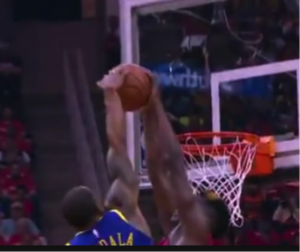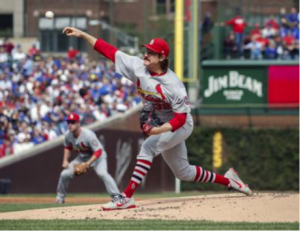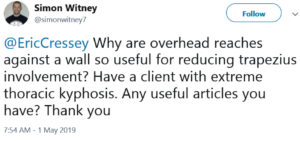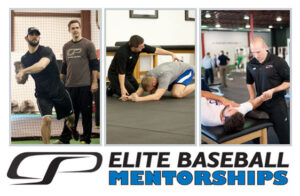
10 Reasons to Use Wall Slides
Today’s guest post comes from my good friend and Elite Baseball Mentorships colleague, Eric Schoenberg. Enjoy! -EC
In response to the tweet below and in preparation for the upcoming CSP Elite Baseball Mentorship in June, we decided to put together an article dedicated to the wall slide.
In this article, we will discuss the top 10 findings from a wall slide assessment. In addition, we cover examples of how different coaching cues can benefit the athlete not only in their sport, but more so, in a particular moment in their sport.
This leads to the thought of using the term movement or “moment-specific” training rather than the overused “sport specific” terminology.
Here is the Tweet/question (thanks, Simon). The direct answer will come at the end of the article.
The wall slide was born through the work of Shirley Sahrmann and outlined in her book – Diagnosis and Treatment of Movement System Impairments.
Through many years of work and countless iterations, we have used and modified the pattern to allow for individualization of overhead activity in all body types and sports.
We use the wall slide as an assessment and an exercise every day with our athletes. It should be noted that the wall slide should serve as a bridge to any overhead activity (OH carries, landmine press, etc.) in your programming.
For each assessment finding using the Wall Slide Test, we use individual cues to assist the athlete in creating the desired movement correction. From there, we program the exercise into the warm-up or main program to help develop movement proficiency.
Here are ten reasons we use wall slides in our assessments:
1. Glenohumeral joint range of motion (ROM) – e.g. shoulder flexion
In the image below, we see Clint Capela and Andre Iguodala exhibiting adequate shoulder flexion, however, a slight lack of height, vertical jump, overhead strength, and timing may have resulted in the unfavorable result for AI.

Source: https://www.cbssports.com/nba/news/rockets-vs-warriors-clint-capela-meets-andre-iguodala-at-the-rim-with-incredible-two-handed-block/
2. Scapulo-thoracic joint ROM – e.g. scapular upward rotation and elevation
3. Cervical spine control – e.g. forward head tendency
4. Thoracic spine positioning – e.g. flat, extended vs. kyphotic, flexed
A clear illustration of the need to properly cue the Wall Slide and other overhead activities as it relates to the Thoracic Spine can be seen in the two pictures below.
a. OBJ’s catch shows elite thoracic extension in the overhead position. If Odell was an athlete that was more biased towards thoracic flexion, then his overhead mobility would be more limited and this iconic catch may have never happened. It is important to cue this pattern in the gym if it is required to happen on the field.

Source: https://ftw.usatoday.com/2014/11/odell-beckham-catch-new-york-giants-replay-youtube-vine-gif
b. In contrast, CSP athlete and St. Louis Cardinals All-Star Miles Mikolas does not require thoracic extension when his hand is fully overhead. In fact, he needs to be in a position of thoracic flexion to help deliver the scapula, arm, and hand at ball release. This pattern must also be trained.

Source: https://www.albanyherald.com/sports/cardinals-sign-pitcher-miles-mikolas-to–year-extension/article_7c3fec36-4408-5ce6-a053-3659320329c1.html
Note: This does not mean that Miles does not need thoracic extension to perform his job. It just means that he does not need to be trained into that position when his arm is fully overhead.
5. Lumbar spine positioning – e.g. excessive lumbar extension
6. Lumbo-pelvic stability – e.g. dropping into anterior pelvic tilt
7. Transverse plane alignment – e.g. spinal curvature or pelvic rotation
8. Lat length – e.g. athlete moves into humeral medial rotation at top of wall slide
In another example of the lat impacting overhead motion and movement quality, Rocky Balboa (not a CSP athlete, unfortunately!), shows a pattern of humeral medial rotation with overhead reaching. Interestingly, since his sport is not defined by vertical motion, but more so horizontal motion, Mr. Balboa does not require as much scapular upward rotation as a baseball player.

Source: https://www.phillyvoice.com/lesson-fake-news-faux-call-removal-rocky-statue/
If we use the Pareto Principle (or the 80/20 rule), general fitness and athleticism should account for 80% of our training. However, the remaining 20% should be tailored to the movements, patterns, and positions that are unique to the athlete’s sport.
9. Motor Control – e.g. faulty scapulohumeral timing, inability to control scapulae eccentrically with arm lowering
10. Faulty activation patterns – e.g. overuse of upper trapezius vs. proper serratus and lower trapezius activation
In summary (and to answer the original question in the tweet above), the overhead reach (wall slide) is helpful to decrease upper trapezius involvement if the exercise is cued to do so. The ability to properly recruit serratus and lower trapezius to assist with scapular upward rotation will lessen the “need” for the upper trap to jump in too much. Remember, the upper trap does need to play a role in this movement, it just shouldn’t be doing all of the work.
As for the “extreme thoracic kyphosis” part…. It is important to first determine if this is a structural or functional issue. If it is structural, it will not change. In this case the wall slide can be used to train within this constraint to assist your client in finding solutions to get overhead. On the other hand, if the kyphosis is functional (meaning it can be changed), then the secret sauce is differentiating weakness, stiffness, shortness, and/or motor control issues as the reason for the kyphosis and difficulty getting overhead. The Wall Slide is a great tool to help tease that out to help your client.
If you want more information about this and many other aspects of the approaches that we utilize to manage the overhead athlete, please consider joining us June 23-25 at our Elite Baseball Mentorship program at CSP in Hudson, MA. The early-bird registration deadline is May 23.
This Cressey Sports Performance Elite Baseball Mentorship has a heavy upper extremity assessment and corrective exercise focus while familiarizing participants with the unique demands of the throwing motion. You’ll be introduced to the most common injuries faced by throwers, learn about the movement impairments and mechanical issues that contribute to these issues, and receive programming strategies, exercise recommendations, and the coaching cues to meet these challenges. For more information, click here.
About the Author
Eric Schoenberg (@PTMomentum) is a physical therapist and strength coach located in Milford, MA where he is co-owner of Momentum Physical Therapy. Eric is addicted to baseball and plays a part in the Elite Baseball Mentorship courses at Cressey Sports Performance. He can be reached at eric@momentumpt.com.





